Producing fuel briquettes from sugarcane waste - Engineers Without ...
Producing fuel briquettes from sugarcane waste - Engineers Without ...
Producing fuel briquettes from sugarcane waste - Engineers Without ...
You also want an ePaper? Increase the reach of your titles
YUMPU automatically turns print PDFs into web optimized ePapers that Google loves.
EWB-UK National Research & Education Conference 2011<br />
‘Our Global Future’<br />
4 th March 2011<br />
<strong>Producing</strong> <strong>fuel</strong> <strong>briquettes</strong> <strong>from</strong> <strong>sugarcane</strong> wast<br />
Chesta Tiwari<br />
Chesta.tiwari@ewb-uk.org<br />
Supervisor: Dr Stephen Beck, s.beck@sheffield.ac.uk<br />
Mechanical Engineering Department, University of Sheffield<br />
Partnered with: Prakti Design, Puducherry<br />
Abstract<br />
Prakti Design have developed an improved cooking stove to be <strong>fuel</strong>led by <strong>briquettes</strong>; in order to tackle inefficient <strong>fuel</strong><br />
combustion, emissions and the accompanying serious health risks. Prakti Design is based in one of the highest <strong>sugarcane</strong><br />
producing regions in the world. This paper looks at the potential of briquetting <strong>sugarcane</strong> <strong>waste</strong> and production of this<br />
alternative to <strong>fuel</strong>-wood in order to address the global concerns of deforestation and the related environmental<br />
degradation.<br />
Keywords<br />
Fuel Briquette: compacted material that is suitable for use as an alternative to wood and other sources of energy such as<br />
charcoal and LPG (Liquefied Petroleum Gas).<br />
Sugarcane Waste: covers all the by-products and secondary by-products that come <strong>from</strong> cane sugar production. (S.C.W)<br />
Introduction<br />
The <strong>sugarcane</strong> plant is an exemplar of how nature can provide us with renewable resources to sustain ourselves without<br />
dependency upon unsustainable and damaging fossil <strong>fuel</strong>s. Across the world research is being done to see how this<br />
humble plant can be used to provide alternatives to anything <strong>from</strong> petrol to plastics. More interest is being generated in<br />
the alternative uses of such plants and agro-<strong>waste</strong> as the impacts of global warming and deforestation become more and<br />
more evident. Deforestation is harmful both on a global scale, with diminished overall potential for CO 2 sequestration,<br />
and on a local scale, with increased risk of soil erosion which can lead to desertification and subsequent malnutrition or<br />
even famine.<br />
The geographical location of Puducherry in relation to the Western Ghats mountain range means it has a natural aridity,<br />
which, combined with often heavily-irrigated irrigated agriculture and the monsoon climate mean soil erosion and subsequent<br />
desertification are more likely. Project Green Hands, a tree-planting NGO in the region set up in 2005 in response to the<br />
tsunami, set itself the goal of increasing green-cover back up to 33% to reverse the environmental degradation. (Project<br />
Green Hands, 2010) India is not well known for deforestation rate, but "If one subtracts plantations <strong>from</strong> total forest<br />
cover then India’s native forests have actually declined at an alarming pace, <strong>from</strong> 0.8% to 3.5% per year," meaning<br />
during 2000-20052005 India suffered <strong>from</strong> a higher rate of forest loss than even Brazil and Malaysia. (Puyravaud, Davidar, &<br />
Laurance, Vol. 329, July 2010) Briquetted agricultural <strong>waste</strong> (agro—<strong>waste</strong>) <strong>from</strong> existing crops can provide an alternative<br />
to wood and can therefore reduce the deforestation rate.<br />
The usage of agro-<strong>waste</strong> products, such as S.C.W, also avoids the cost and environmental impact of otherwise dealing<br />
with them. In some regions, S.C.W is burnt in-field, but this is a <strong>waste</strong> of energy and adds to Green House Gas (GHG)<br />
emissions.<br />
Prakti Design<br />
In 2009 Prakti Design won the Partnership for Clean Indoor Air (PCIA)’s Special Achievement Award and reached the<br />
finalist stages of the Sankalp Awards, India’s first social enterprise and investment forum. The organisation designs and<br />
develops affordable improved cooking stoves used in communities <strong>from</strong> Mauritania to Haiti, and have recently adapted a<br />
stove specifically to be used with <strong>briquettes</strong>. They have previously been linked with EWB-UK projects after being found as<br />
an in-field contact (Selco ICS project, 2008).<br />
Briquetting<br />
The densification of biomass into <strong>briquettes</strong> brings the advantages of:<br />
• Removing moisture <strong>from</strong> the material<br />
• Improving bulk density<br />
• Increasing the net calorific value per unit volume, subsequently reducing cost per calorific value of <strong>fuel</strong>.<br />
• Cost reduction in transportation<br />
• Cost-effective for user<br />
Panel Presentation: Energy<br />
Author: Chesta Tiwari<br />
Institution: University of Sheffield<br />
39
EWB-UK National Research & Education Conference 2011<br />
‘Our Global Future’<br />
4 th March 2011<br />
• Usage of biomass beyond its availability period. (Organisation for Economic Co-operation operation and Development, 2004)<br />
Crushing season is usually November to May in the vicinity (Puducherry Cooperation Sugar Mill, 2007) Briquetting enables<br />
year-round usage of ready-to-use agro-<strong>waste</strong>, with efficient storage and transportation thus reduced costs. The idea of<br />
using S.C.W <strong>from</strong> existing crops was to generate <strong>fuel</strong> <strong>from</strong> a product that would otherwise be thrown away or used<br />
inefficiently; rather than the wood commonly used, reducing both cost and GHG emissions associated with otherwise<br />
disposing of <strong>waste</strong>, as well as reducing <strong>fuel</strong>-related deforestation.<br />
S.C.W, in particular bagasse, has been used in the form of carbonised <strong>briquettes</strong> in Haiti amongst other places, but the<br />
decision was made to investigate non-carbonised <strong>briquettes</strong> to simplify the process, to encourage production and usage<br />
and make the cheapest effective <strong>briquettes</strong> possible.<br />
Availability<br />
India is the second biggest <strong>sugarcane</strong> growing country in the World, only behind Brazil. Puducherry has many <strong>sugarcane</strong><br />
plantations of its own, and surrounding Tamil Nadu is one of the biggest <strong>sugarcane</strong> growing states in India. The main<br />
<strong>waste</strong> product of <strong>sugarcane</strong> production is a material known as bagasse.<br />
Bagasse is the fibrous residue that remains in large quantities upon the crushing of <strong>sugarcane</strong> to remove the sugar juices.<br />
For each tonne of <strong>sugarcane</strong> crushed, about 300 kg of bagasse is retrieved.<br />
Many Indian <strong>sugarcane</strong> factories operate co-generation plants, where about 50% of the bagasse produced is used to<br />
power the factories themselves. The majority that rests is sold to paper-mills as an alternative to wood pulp. Tamil Nadu<br />
has one of the world’s largest bagasse-based based paper mills, Tamil Nadu Newsprint & Papers Ltd. (CPCB, 2010). The papermaking<br />
process requires de-pithed bagasse, creating a second <strong>waste</strong>, bagasse pith. (Hurter, 2007)<br />
Bagasse Pith is cellulose but not fibrous, and must be removed <strong>from</strong> bagasse in order to make good quality pulp <strong>from</strong><br />
which to produce paper. Bagasse pith is usually removed in a process known as “moist de-pithing” in the sugar factory<br />
itself.<br />
Methods and Results<br />
Current Fuel<br />
Research done with Prakti gave the characteristics of the <strong>fuel</strong>-wood to compete with, as shown in Table 1.<br />
Fuel<br />
Cost<br />
Calorific Value (when<br />
completely dry)<br />
Quantity<br />
Required for 1<br />
average meal*<br />
Cost of <strong>fuel</strong>/meal<br />
Split Wood<br />
Non-split Wood<br />
5 Rs/kg<br />
4 Rs/kg<br />
19-21 MJ/kg 1.34 kg<br />
6.7 Rs<br />
5.4 Rs<br />
Table 1: Characteristics of the Fuel-wood used in the region<br />
* The average cooking time was calculated for lunch: traditional meals were prepared by a local cook, on an Improved<br />
Cooking Stove (ICS) designed by Prakti, and the average wood used was recorded. The average weight of food cooked<br />
was 3.53 kg, a large meal, to feed 4 people, including rice, and several different vegetables. This gives 0.335kg<br />
wood/person/meal, however the ICS gives an approximate 50% <strong>fuel</strong> reduction. Based on Prakti’s experience in both India<br />
and Africa, wood consumption in a traditional 3-stone cooking stove is roughly 1kg/person/day.<br />
Properties of Sugar Cane Waste<br />
The first stage of the research into finding the solution was to decide upon what type or types of S.W.C. to briquette.<br />
Bagasse, press mud, molasses and bagasse pith were all considered. Sugar cane factories were only able to provide<br />
samples of bagasse and bagasse pith for testing, because the crushing season had ended, but other data sources were<br />
found to compare properties.<br />
The main problems in briquetting bagasse are that it requires a lot of processing, due to:<br />
• large particle sizes (10mm average length)<br />
• “springy nature”<br />
• high moisture content<br />
These factors could be addressed in the press design although the added complexity would increase both immediate and<br />
long-term (maintenance) costs.<br />
Bagasse pith is a fraction of the cost of bagasse, the local <strong>sugarcane</strong> factory charged approximately 4% of the cost of<br />
bagasse, at only 450 Rs/tonne (about £6.40/tonne). This is also much cheaper than municipal <strong>waste</strong> in the region being<br />
Panel Presentation: Energy<br />
Author: Chesta Tiwari<br />
Institution: University of Sheffield<br />
40
EWB-UK National Research & Education Conference 2011<br />
‘Our Global Future’<br />
4 th March 2011<br />
collected by local <strong>waste</strong>-collecting NGO Shuddham (e.g. cardboard at 4000-6000 Rs/tonne (Shuddham, 2010)) previously<br />
considered as a source of briquetting material). Secondly, although research uncovered experimentation to find a use for<br />
bagasse pith in other domains, such as cattle fodder, no published evidence ence has been found of usage in briquetting.<br />
A bomb calorimeter was used to find calorific value, results shown in Table 2 illustrating that bagasse pith has a<br />
comparable calorific value to <strong>briquettes</strong> currently used around the world, and other <strong>fuel</strong>-sources. es. Being organic materials,<br />
the S.C.W <strong>from</strong> the region could differ significantly in properties <strong>from</strong> that <strong>from</strong> a region in a different climate, (University<br />
of Natal, Mechanical Engineering Department, 1977), so this experimentation was vital.<br />
Calorific Values of Organic Samples<br />
Bagasse<br />
Try 1<br />
Bagasse<br />
Try 2<br />
Bagasse<br />
Briquette<br />
(Compressed<br />
Bagasse with<br />
possible<br />
binder)<br />
Bagasse<br />
Pith<br />
Sawdust<br />
Sawdust/<br />
binder<br />
(Kerala<br />
briquette)<br />
Sawdust/<br />
Paper/<br />
Cardboard<br />
(Haiti<br />
briquette)<br />
Waste<br />
paper/<br />
coffee<br />
husks<br />
(Bangladesh<br />
briquette)<br />
Weight (dry)<br />
[g] 0.9252 0.966 0.99901 1.0101 1.0365 1.02261<br />
Temperature<br />
Change [°C] 1.644 1.6389 1.88255 1.7409 2.0532 1.8457<br />
Calorific<br />
Value<br />
[MJ/kg] 18.1 17.3 19.2 17.6 20.2 18.4<br />
1.02 1.02<br />
2.0532 1.78<br />
20.5 17.8<br />
Table 2: Calorific values of samples as found using the bomb calorimeter.<br />
The results for bagasse were comparative to other results found <strong>from</strong> various sources including Bio<strong>fuel</strong>sb2b (Bio<strong>fuel</strong>sb2b,<br />
2007) which listed 17-18 MJ/kg. However results for bagasse pith were much higher than that found in Avant Garde<br />
India, which listed 2000 kcal/kg, the equivalent of about 8.4 MJ/kg, less than half of the 17.6 MJ/kg found in the bomb<br />
calorimeter experiment run.<br />
Waste<br />
Bagasse<br />
Bagasse Pith<br />
Press Mud<br />
Molasses<br />
Percentage of weight of Sugarcane Crushed<br />
30%<br />
[50% of weight of bagasse to be de-pithed]<br />
3-8%<br />
3-5%<br />
Table 3: Quantities of <strong>waste</strong> per weight processed (Sugar Industry Waste, 2010), (Avant Garde India)<br />
Table 3 shows quantity but the actual availability of <strong>waste</strong> was also vital- in order to handle molasses in India, a special<br />
permit is required due to the fact that molasses can be used to make alcohol. Alcohol is a controlled substance in Tamil<br />
Nadu and the sale of alcoholic beverages is the monopoly of the state government. Molasses has a low calorific value, and<br />
would only have been considered as a potential binding agent for the main agro-<strong>waste</strong>. As we wanted small businesses or<br />
schools to benefit <strong>from</strong> briquetting, and the briquetting material to which the press would be tailored, molasses was<br />
eliminated as a potential binding agent.<br />
Panel Presentation: Energy<br />
Author: Chesta Tiwari<br />
Institution: University of Sheffield<br />
41
EWB-UK National Research & Education Conference 2011<br />
‘Our Global Future’<br />
4 th March 2011<br />
Chosen Waste<br />
Bagasse pith was decided upon as the calorimeter data supported the good od physical briquetting property of bagasse pith,<br />
as shown in figure 2.<br />
Bagasse pith has an ash content of 8% (RWEDP Energy) which is<br />
acceptable for a <strong>fuel</strong> briquette. However, containing 48% - 52% moisture<br />
(Avant Garde India), the material remained damp, even months after being<br />
removed <strong>from</strong> the factory. Therefore, research needed to be done into the<br />
value that drying the material might bring to briquette quality, and how<br />
this could be achieved.<br />
Figure 1: Image of bagasse pith briquette made<br />
on car-jack press constructed in Puducherry<br />
Investigation into Drying<br />
Prakti Design has its own solar drier, as shown in Figure 2. . Investigation will be carried out<br />
into how well bagasse pith can be dried without the use of any extra energy. The monsoon<br />
season in Puducherry runs <strong>from</strong> October till December, with heavy rains starting as early as<br />
August, and the ability of the solar drier to work under such conditions would also need<br />
research. Investigation into how successfully bagasse pith responds to drying is being<br />
carried out in England, through simple radiator experiments where it has been found to dry<br />
quite successfully within a few weeks.<br />
Figure 2: Prakti Design’s Solar Drier<br />
Investigation of Press Designs: Brief discussion of types of presses available<br />
Discussion with the CEO of Prakti Design generated the outline design specification for the briquetting press:<br />
• Less than 100 USD<br />
• Largely Manual<br />
• Production of 50 <strong>briquettes</strong>/day possible<br />
• Cheap to run and maintain<br />
Above all, we wanted the press to use appropriate technology- to be constructed <strong>from</strong> locally available materials, in local<br />
workshops using techniques that were already practised or that could be taught and passed on. Research was conducted<br />
into briquette presses used on a similar small scale in international development, <strong>from</strong> simple lever presses used in<br />
communities to the more complex heated die screw-press.<br />
Panel Presentation: Energy<br />
Author: Chesta Tiwari<br />
Institution: University of Sheffield<br />
42
EWB-UK National Research & Education Conference 2011<br />
‘Our Global Future’<br />
4 th March 2011<br />
Car-jack Presses /<br />
Bottle-jack Presses<br />
e.g. Echo press design<br />
Briquette<br />
Presses<br />
(Heated)<br />
Die screw presses<br />
e.g. AIT design<br />
Wooden compound levers<br />
e.g. Legacy Foundation design<br />
Investigation into each of these types of press designs to find their relative merits and disadvantages will be done, to add<br />
to general brainstorming, also taking into account the feasibility of building the presses with cheap locally-available<br />
resources.<br />
Feedback <strong>from</strong> Field Trip<br />
Due to some experience of international development projects communication difficulties were expected, but not to the<br />
extent experienced. Time expected to complete tasks was increased by problems such as:<br />
• locating <strong>sugarcane</strong> factories<br />
• arranging meetings<br />
• obtaining samples of S.C.W<br />
This was due to a variety of factors- for example:<br />
• Research done whilst in England was found on arrival to be out of date, , with <strong>sugarcane</strong> factories listed which had<br />
since changed contact details, location, or even ceased to exist.<br />
• Sugarcane plantations only rarely had their own websites (unsurprisingly) making it difficult if not impossible to<br />
contact anyone without actually travelling to location. This also took time away <strong>from</strong> other research that needed to be<br />
done in the field.<br />
• Bureaucracy involved in obtaining samples, meaning more trips.<br />
• Changes in address or poor infrastructure<br />
• Language barriers and subsequent dependency on colleagues, , as it was difficult to find an appropriate time to trips to<br />
other <strong>sugarcane</strong> factories that were further away due to their own work commitments. Language barriers also<br />
occasionally led to miscommunication of information between myself and my colleagues.<br />
The very short time period between finalising the project and going out on the field trip, which unfortunately was<br />
unavoidable, meant that I was not as prepared as I would have liked to have been. Before any subsequent trip I would<br />
try to:<br />
1. Contact more organisations in advance, particularly to arrange meetings and raise interest<br />
2. Find more technical external contacts in the field beforehand<br />
3. Improve my Tamil, , particularly technical vocabulary.<br />
However, the act of going to the location and working with the partner organisation before officially starting the<br />
dissertation ion research really helped the progress of the project, and I recommend it. I was able to attack the project well<br />
<strong>from</strong> the start, knew what I was doing when I officially began my dissertation and had continued support <strong>from</strong> those that<br />
I had worked with during working at Prakti Design.<br />
Conclusion and Future Steps<br />
Bagasse pith is:<br />
• available, being<br />
- the secondary <strong>waste</strong> product of <strong>sugarcane</strong>, an abundant crop both in Puducherry and India as a whole,<br />
where the majority of factories de-pith and sell the bagasse not required for co-generation to paper<br />
mills<br />
- and without a distinct alternative use; of which all current uses still require considerable processing<br />
• relatively high calorific value (similar to bagasse and the composition of <strong>briquettes</strong> currently used in the<br />
calorimetry test)<br />
Panel Presentation: Energy<br />
Author: Chesta Tiwari<br />
Institution: University of Sheffield<br />
43
EWB-UK National Research & Education Conference 2011<br />
‘Our Global Future’<br />
4 th March 2011<br />
• relatively low cost (4% cost of bagasse which is already used in briquetting)<br />
and naturally comes in<br />
• small particles (particularly compared to bagasse, already used in briquetting).<br />
Pre-processing<br />
Investigation to determine how much pre-briquetting drying will be conducted; if solar drying experimentation proves<br />
successful, great expense and energy-usage will be saved. but the issue of solar drying during monsoon conditions will<br />
still need investigation.<br />
Briquette Composition<br />
Briquette te “recipes” and pressure applied will be experimented with. The addition of a binding agent may also need to be<br />
considered, depending on the results of initial performance testing using a simple press (simulation) arrangement.<br />
Possible locally-availabel materials to be considered as binders include clay and cassava starch.<br />
Press Designs<br />
Although likely to be conducted outside the time-scale of the final year project, a press tailored to bagasse pith briquette<br />
production will be constructed, leaving an educational tool to be used for training events, particularly for EWB-Sheffield.<br />
Detailed plans using appropriate local technology would become open-source on the internet if deemed different enough<br />
to existing presses.<br />
Application<br />
A briquette enterprise that could be set up with the press would introduce new jobs into a community- <strong>from</strong> collection of<br />
the raw materials and management of any processing required such as solar drying, to operating and maintaining the<br />
press and distribution of the <strong>briquettes</strong>. Schools and cooperatives interested in using the <strong>briquettes</strong> are being researched.<br />
Prakti’s specially designed stove is currently successfully being trialled in Haiti by a school, and it was found that the local<br />
<strong>sugarcane</strong> factory to Puducherry has built its own school especially for the children of its workers. This is being focused on<br />
as a possible benefactor of <strong>fuel</strong> briquette production. With<br />
• favourable prices likely<br />
• no transport costs- if production could be done on school-site (next to factory)<br />
• potential for agro-briquette educational workshops to demonstrate solutions to deforestation and global warming and<br />
teach the production technique,<br />
briquette production could prove not only particularly cost-effective, but also beneficial here.<br />
If the overall cost of the briquette could compete with <strong>fuel</strong>-wood per tonne then they could be used elsewhere on a<br />
similar scale, perhaps eventually even in other big <strong>sugarcane</strong> producing Indian states, making some leeway into tackling<br />
deforestation.<br />
Acknowledgements<br />
Many thanks go to the following organisations, and particularly to the following people:<br />
Department of Mechanical Engineering, University of Sheffield: Dr. Stephen Beck (Dissertation Supervisor) for all his<br />
enthusiasm, advice and for helping me ensure that the project continues to meet the technical criteria the University<br />
demands. Mike Rennison (Experimental Officer) for his perspective and advice on testing and design.<br />
The whole team at Prakti Design, , particularly: Mouhsine Serrar (CEO), V Ganesh (Technical and Research Assistant), and<br />
S Nithya (Engineering Support), for welcoming me into their team, supporting my research and helping out with<br />
experimentation particularly after my departure.<br />
<strong>Engineers</strong> <strong>Without</strong> Borders-UK: Katie Cresswell-Maynard for offering support and advice whenever required, particularly<br />
<strong>from</strong> an international development perspective.<br />
Panel Presentation: Energy<br />
Author: Chesta Tiwari<br />
Institution: University of Sheffield<br />
44
EWB-UK National Research & Education Conference 2011<br />
‘Our Global Future’<br />
4 th March 2011<br />
Bibliography<br />
Avant Garde India. . (n.d.). Retrieved 2010, <strong>from</strong> http://www.avantgardeindia.com/techpapers/Utilisation%20of%20Pith%20as%20Boiler%20Fuel.pdf<br />
Bio<strong>fuel</strong>sb2b. (2007). Bio<strong>fuel</strong>sb2b. . Retrieved 2010, <strong>from</strong> http://www.bio<strong>fuel</strong>sb2b.com/useful_info.phppage=Typic<br />
Buffington, D. E., & Wilson, T. O. (n.d.). Agricultural and Biological Department, Pennsylvanian University. Retrieved <strong>from</strong><br />
http://www.abe.psu.edu/extension/factsheets/h/H82.pdf<br />
CPCB. (2010). Central Pollution Control Board. Retrieved December 2010, <strong>from</strong> Paper Mills:<br />
http://www.cpcb.nic.in/oldwebsite/New%20Item/pub_paper_mills_chapter-4a.html<br />
Hurter, R. W. (2007). Developments in Pulp and Paper Manufacture <strong>from</strong> Sugarcane Bagasse. Bagasse Fibre Processing<br />
Overview. Brisbane: Hurter Consult Incorporated.<br />
India Water Portal. . (n.d.). Retrieved <strong>from</strong> http://www.indiawaterportal.org/node/115<br />
Organisation for Economic Co-operation operation and Development. (2004). Biomass and Agriculture: Sustainability, Markets and<br />
Policies. OECD Publishing.<br />
Project Green Hands. . (2010). Retrieved 2010, <strong>from</strong> http://www.projectgreenhands.org/the-facts<br />
Puducherry Cooperation Sugar Mill. . (2007). Retrieved 2010, <strong>from</strong> http://cooperation.puducherry.gov.in/sugarmill.html<br />
Puyravaud, J.-P., Davidar, P., & Laurance, W. (Vol. 329, July 2010). Cryptic Loss of India's Forests. Science .<br />
RWEDP. (n.d.). Retrieved <strong>from</strong> http://144.16.93.203/energy/HC270799/RWEDP/acrobat/fd46.pdf<br />
RWEDP Energy. . (n.d.). Retrieved <strong>from</strong> http://wgbis.ces.iisc.ernet.in/energy/HC270799/RWEDP/acrobat/fd46.pdf<br />
Shuddham. (2010). Waste Questionnaire.<br />
Sugar Industry Waste. . (2010). Retrieved 2010, <strong>from</strong> Primary Info: http://www.primaryinfo.com/projects/sugar-industry-<br />
<strong>waste</strong>.htm<br />
University of Natal, Mechanical Engineering Department. (1977). Retrieved November 2010, <strong>from</strong><br />
http://www.sasta.co.za/wp-content/uploads/Proceedings/1970s/1977_Don_Calorific%20Values%20Of%20South.pdf<br />
content/uploads/Proceedings/1970s/1977_Don_Calorific%20Values%20Of%20South.pdf<br />
• Echo Press: http://www.food-security.info/pdf%20(English)/ECHO%20(English)/Briquete.pdf<br />
• Legacy Foundation Press designs: http://www.legacyfound.org/<br />
• AIT Press design: www.retsasia.ait.ac.th/briquetting_adap_research.htm<br />
Panel Presentation: Energy<br />
Author: Chesta Tiwari<br />
Institution: University of Sheffield<br />
45


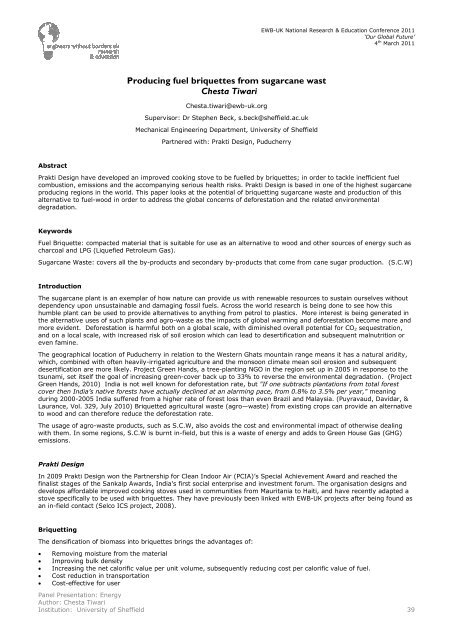
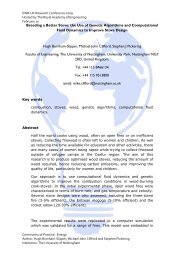
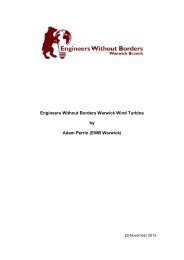
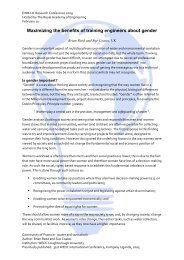
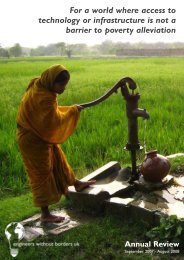
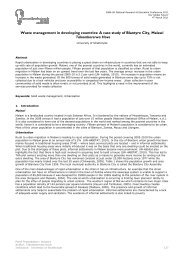
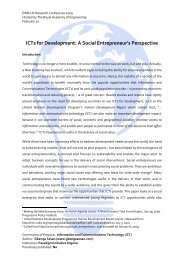
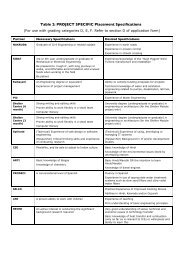

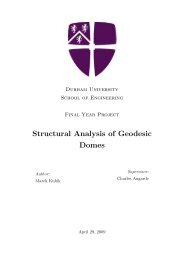
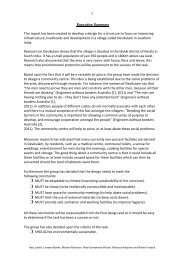


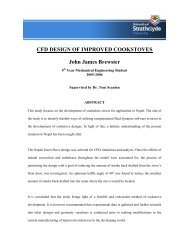
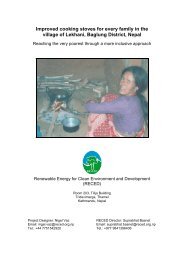
![Ethical Fundraising Guidance[1].pdf - Engineers Without Borders UK](https://img.yumpu.com/36288951/1/184x260/ethical-fundraising-guidance1pdf-engineers-without-borders-uk.jpg?quality=85)